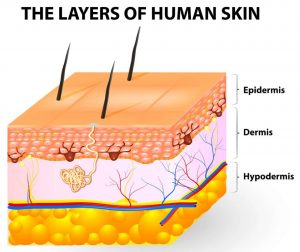How Did Different Human Skin Colours Come About ?
 Skin colour is the result from the presence of a pigment called melanin, located in the epidermis, or outer skin layer, and produced by cells called melanocytes.
Skin colour is the result from the presence of a pigment called melanin, located in the epidermis, or outer skin layer, and produced by cells called melanocytes.
Melanin acts as a protective shield against ultraviolet radiation and helps prevent sunburn damage that can lead to melanoma (skin cancer).
There are several theories concerning the evolution of skin colour…
 A long-held theory suggested that people in the tropic regions near the equator developed dark skin to block out the stronger Sun. The weaker the ultraviolet light, the lighter the skin. The greater levels of melanin in dark skinned people would prevent them from overdosing on vitamin D, which can be toxic in high concentrations. However, critics of this theory say that it is impossible to overdose on natural levels of vitamin D.
A long-held theory suggested that people in the tropic regions near the equator developed dark skin to block out the stronger Sun. The weaker the ultraviolet light, the lighter the skin. The greater levels of melanin in dark skinned people would prevent them from overdosing on vitamin D, which can be toxic in high concentrations. However, critics of this theory say that it is impossible to overdose on natural levels of vitamin D.
Humans need some ultraviolet rays to penetrate the skin in order to produce vitamin D, which is needed for the intestines to absorb calcium and phosphorus from food and deposit it in our bones. Lack of vitamin D results in rickets in children and osteoporosis in adults.
People living above fifty degrees north latitude or below fifty degrees south latitude have a much higher risk of vitamin D deficiency. Only the ability to fish, which provides access to food rich in vitamin D, allowed early humans to live in temperate and polar climates.- A newer theory proposes that differences in skin colour are related to the fact that ultraviolet light from the Sun affects the level of folic acid (a type of vitamin B) in the body. An hour of intense sunlight can cut a light-skinned person’s folic acid level in half. So blocking the degradation of this vitamin would obviously be very useful.
So the theory is that people who live in the tropics developed dark skin to block out the Sun and protect their folate reserves. People who live farther north or south evolved to have fairer skin so they could absorb more ultraviolet light from the Sun and produce needed vitamin D, but they also need to get more of their folic acid from their diet. Fair-skinned people also have a higher risk of skin cancer. Low levels of folic acid are associated with neural tube defects, such as spina bifida. - Some anthropologists believe that both theories may be correct. They believe people close to the equator developed darker skin to block out the Sun and protect their body’s folic acid reserves. People closer to the polar reaches developed lighter skin to produce adequate amounts of vitamin D during the longer winter months.
So, rather unsatisfyingly, the answer is not entirely clear.






